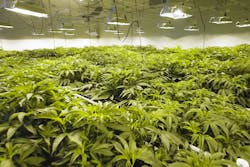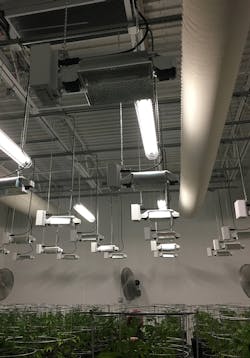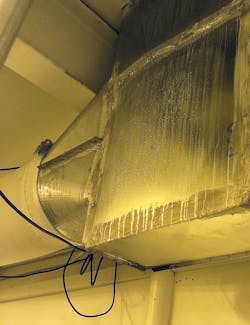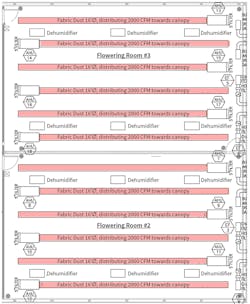Cannabis Room Productivity Relies on Ventilation Design
HVAC ventilation strategies can often mean the difference between success or failure for a cannabis grow facility.
Currently, HVAC design engineers rely on manufacturers with successful applications, because this fledging industry has no guidelines yet from the American Society of Heating, Refrigerating and Air Conditioning Engineers (ASHRAE).
Therefore, ventilation strategies vary greatly to service a wide spectrum of environmental conditions, such as lighting duration, temperature, and humidity – all ingredients to a master grower’s “secret sauce.” Complicating matters is the fact that master growers are reluctant to share information on their environmental condition successes, including their own ventilation strategies.
However, there is one huge ventilation trend. Grow facilities are increasingly opting for fabric duct versus metal duct in their grow/flowering rooms. The movement toward fabric is a hedge to prevent condensation and biological contaminants such as mold, mildew and fungi that can grow on metal ductwork interior and exterior surfaces.
Because the rooms are typically conditioned from 75° to 80°F and 50-70% relative humidity (RH), condensate can easily form on cold surfaces. Consequently, metal duct in these environments requires double-wall or single-wall wrapped in insulation, which can double or even triple material costs. Biological contaminants can become uncontrollable when condensation is ignored. Uncontrolled mold growth can ruin an entire crop at a loss of tens of thousands of dollars. Therefore, eliminating condensation is a critical challenge for master growers and designers.
Fabric duct, on the other hand, uses several strategies inherent in its technology to prevent condensation and mold growth. For instance, it can be specified as permeable, which allows air to pass through the fabric weave. This airflow over the entire duct surface prevents condensation on the material. Fabric duct also doesn’t require insulation or special coatings to protect against corrosion or rust. The polyester fabric used in grow facilities should be UL-2518 classified. Primarily referenced for flame and smoke compliance, UL 2518 also requires a test demonstrating that a fabric swath sealed in a 100% RH environment for 60 days does not propagate biological growth. It can also be specified with an additional anti-microbial agent embedded in the material.
Condensation Consequences and Structural Concerns
Another metal duct negative is the zinc used in its galvanization process. Condensation helps leach zinc out of the galvanization, which can then drip into the soil below. The plants absorb the zinc, which can create a poisonous affect when burned and inhaled. Consequently, industry regulatory tests inspect cannabis for heavy metal trace elements. Plants testing positive for heavy metals are destroyed.
Retrofitting former industrial buildings is popular in the grow industry, but requires growers to gut the interiors, and install all new HVAC systems. One precaution with designing retrofits is assuring the proposed duct can be supported by the existing roof structure. Existing building structures are typically not designed to support tons of additional metal duct for new HVAC systems. Fabric duct is 90% lighter than metal (<2lbs/ft), and does not require seismic or structural considerations.
Mastering Airflow Strategies for Sensitive Grow Rooms
There are several stages of cannabis cultivation and all have their own room and environmental conditions. Fabric duct can be specified in all environments, but it is extremely critical for the main grow or flowering rooms. Grow rooms are considered extreme environments because of the relatively high heat and RH and the critical nature of the product contained in the space. The master grower dictates what environmental set points figure into the recipe for the most productive growth. Typically, master growers prefer airflow that eliminates microclimates throughout the canopy (top of the plants), but not one that delivers too much cold air that can shock plants.
Like metal, fabric duct offers a variety of dispersion methods. The vents are typically positioned as linear arrays along the duct length, which provide a more uniform air dispersion that is superior to the metal duct’s typical registers in 5-ft to 10-ft increments. Grow facility ceilings usually range from 9-ft to 30-ft high, therefore vent styles vary according to the throw and velocity that master growers require to reach the canopy. For most applications under 20-ft high, a medium directional throw vent with perforations between 1/4- to 1/2-inch-diameter is ideal. Larger perforations are used to throw the air further when necessary. Designers also have the flexibility of customizing the placement and quantity of dispersion patterns. Vents in grow rooms are most often directed towards the plants, with throws customized to deliver specific velocities at the canopy.
Another consideration is the placement of ducts in relation to the lighting systems. Ducts are mounted above lighting to prevent shading, but the heat from the lights can create a thermal barrier. Therefore, the air discharge velocity must be able to penetrate this thermal barrier to reach the canopy. However, care must be taken to prevent blowing directly at lights as this can affect the output spectrum from the lights themselves. A good rule of thumb is to reach the canopy with a 150-CFM velocity.
While all grow facilities may seem similar in scope, most master growers’ “secret recipes” depend on specific environmental conditions that fabric duct manufacturers can help to pinpoint with customization.
Air Distribution Design
Duct runs mounted over the plants as opposed to a room perimeter system are very effective and popular.
In an example of a 50-x-100-ft room, a good design might alternate 40-ft duct runs and HVAC systems on one side of the room, and then specify the same configuration on the opposing side of the room. (See diagram). The air handlers can be ceiling-mounted, floor-standing, or positioned outside the walls. This design is ideal in a grow room, because instead of a return on one side of the room, return air strategies can simply consist of grills on each unit throughout the room, without the need of return air ductwork.
This return air strategy pulls air from both sides of the room to prevent air stratification, hot and cold spots, or humidity congregation. So it is a smart design with fabric or metal, but the former’s reputation for uniform air distribution adds to the efficacy of that choice.
Also, fabric duct can be suspended from the structure in a number of ways. The best suspension is dependent on the grow space’s specifics. Single cable systems are often the simplest to install for straight ducts and the lowest cost to purchase. Flush-mounted T-rail systems work well for ducts mounted close to the ceiling, and allow the easiest removal for laundering and maintenance.
Suspended H-Rail systems are the best option for ducts with elbows and offsets, and those that hang well below the structure. Cable and hardware are available in galvanized or stainless steel, and rails are supplied in anodized aluminum, meaning all components are ideal for the humid environment.
Washable Benefits
Maintaining cleanliness inside ductwork is essential in any environment, especially a room with tons of soil, thousands of plants, and water. Metal duct can be cleaned in place, but the EPA does not recommend it. Why? Because it can dislodge dormant biological contaminants into the immediate environment. Disassembling and reassembling metal duct would require considerable cost, weeks of work and downtime.
In contrast, in the example of the 50-x-100-ft room, fabric can be removed in a few hours by a two-person crew and commercially laundered.
That cleaning process can actually be planned in the grow process. For example, a grower might have four grow rooms of various stages of maturity. All the rooms have identical fabric duct systems. Once a room is harvested, a fifth, recently-cleaned fabric system can be substituted for the harvested room’s system that is then cleaned. That way, there is no downtime in establishing the new room with the plants because an idle system is ready to be rotated into the next room that’s already been cleaned and prepared for growing.
Energy Efficiency and Labor Savings Tip the Scales
Besides the aforementioned light weight, cleanability and air distribution superiority that fabric exhibits versus metal duct, energy efficiency and labor savings are also benefits. Fabric duct’s air distribution uniformity can lead to improved energy efficiency versus metal duct/register systems. Installation labor can also be reduced by 40 to 70% versus metal systems. Both of these factors can affect operational, as well as project costs.
Looking ahead, as more grow masters standardize their cannabis cultivation as the market grows, strategic ventilation will most certainly figure into the product’s success.
###############
About the authors
Daugherty is the engineering manager for FabricAir, a manufacturer of fabric air dispersion duct for HVAC applications. Now in his eighth year with the firm, he is responsible for training, product innovation, install guidance, and troubleshooting. He holds an agricultural engineering degree from the University of Georgia, and can be reached at [email protected].
Bonnville has been involved in more than 100 grow facility ventilation projects over the last five years. A veteran of 24 years in sheet metal duct design, fabrication, and installation with mechanical contractors, he can be reached at [email protected].




